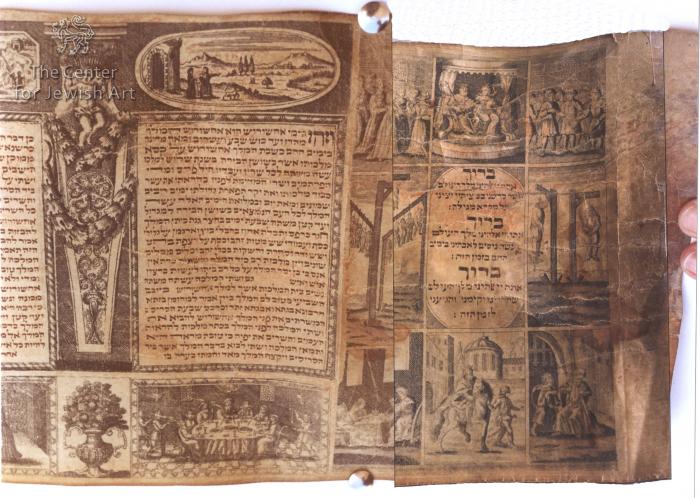Img. ID: 340732

Opening decoration: The scroll opens with a panel containing several narrative scenes from the Esther story. In the decorative panel, in the central part of the upper register, there is the royal couple seated on the throne with a canopy that is placed on a pedestal. The king and queen are accompanied by courtiers; on the right, the princes of Media and Persia are standing (Es. 1:14), and Esther's maidservants stand on the left (Es. 2:9). Below, there are three rectangular frames: the central panel contains the benedictions recited before the Megillah reading, while the panel on the right shows the chamberlains, Bigthan and Teresh, hanging on two gallows (Es. 2:23), and the panel on the left depicts Haman and his sons hanging on three gallows (Es. 7:10 and Es. 9:14 or Es. 9:25). The lowest register contains three episodes (from right to left): Mordecai receiving the clothes from Hatakh (Es. 4:4), Haman leading Mordecai through the streets of Susa (Es. 6:11), and Esther and Mordecai writing letters instructing the Jews to observe Purim (Es. 9:29).
Landscape no. 1 is printed in the upper margin and frame no. 1 is printed in the lower margin. Frame no. 1 depicts the feast of Ahasuerus (Es. 1:3-8), with six men seated at a round laden table. There are servants standing on either side of the table.
C | Columns
A | Acanthus Leaf
G | Garland
P | Putto (Putti in Plural)
B | Basket | Basket with flowers
V | Vase
H | Herm(a)
E | Esther, Book of (following the order of the story) | *Esther's Story Characters (depicted not in narrative scenes): | Ahasuerus and Esther, enthroned
E | Esther, Book of (following the order of the story) | Ahasuerus and the seven princes of Persia and Media (Es. 1:13-15) | Seven princes of Persia and Media (Es. 1:14)
E | Esther, Book of (following the order of the story) | Seven maidens given to Esther (Es. 2:9)
E | Esther, Book of (following the order of the story) | Bigthan and Teresh hanged (Es. 2:23)
E | Esther, Book of (following the order of the story) | Mordecai receiving clothes from Hatach (Es. 4:4)
E | Esther, Book of (following the order of the story) | Mordecai's triumph (Es. 6:11)
E | Esther, Book of (following the order of the story) | Mordecai and Esther writing the Purim letter (Es. 9:29)
E | Esther, Book of (following the order of the story) | Ahasuerus' banquet (Es. 1:3-8)
|
In general, the scroll (the text, the decorations, and parchment) is preserved in very good condition.
The opening, blank, section of the scroll is torn.
The Book of Esther in Hebrew preceded with the benedictions recited before the Megillah reading
The scroll is formed of 4 sheets containing a total of 16 columns of text with 24 or 27 lines each, except for col. 14 with 11 lines divided into two half-columns. Additionally, initial benedictions are written within the opening decoration.
Every sheet contains 4 columns of text.
The text is inscribed in the Hebrew square script in brown ink on the flesh side of parchment membranes.
The letters ח (Es. 1:6) and ת (Es. 9:29) are highlighted by their size. Other enlarged and diminished letters are included in col. 14.
The initial word of the Megillah is enlarged and bolded.
The ruling is made with a hardpoint and is slightly visible.
The sheets in the scroll are stitched together.
The benedictions open with enlarged and bolded words ברוך written separately in the lines. The formulas are inscribed in the square script. Two of them include the ligature of א and ל letters.
None
There are two variants of the scrolls decorated with this pattern that in the Index are marked "I" and "II". In some exemplars, just below the decorative columns, the pedestals with angel's heads and bases were added, therefore, the text panels in these scrolls are higher; this type is marked with "II". Whereas, the rest of the manuscripts containing no pedestals with angel's heads and bases are marked with "I". The latter are more numerous.
The earliest scroll sharing a similar engraved pattern is dated to 1701; this is the megillah BCM 25 from the Braginsky Collection in Zurich (see http://braginskycollection.com/esther-scrolls/; accessed on 22.04.2020).
Similar narrative scenes are included in the scrolls with "portrait medallions" (see in the Index); some of them are their mirror image.
A short description in Spanish and images of the manuscript are available on http://ceres.mcu.es/pages (accessed on 18.10.2020).
Other scrolls sharing the same or similar pattern are discussed for example in:
Jiřina Šedinová, From the Mss. Collections of the State Jewish Museum in Prague. The Scrolls of Esther, „Judaica Bohemiae” 1979, nr 15/2, 79-80.
Dagmara Budzioch, The Decorated Esther Scrolls from the Museum of the Jewish Historical Institute in Warsaw and the Tradition of Megillot Esther Decoration in the Seventeenth and Eighteenth Centuries – An Outline [Polish: Dekorowane zwoje Estery z Żydowskiego Instytutu Historycznego w Warszawie na tle tradycji dekorowania megilot Ester w XVII i XVIII wieku. Zarys problematyki], Warsaw 2019, 1:163-176, 2:41-49.
A Journey through Jewish Worlds: Highlights from the Braginsky Collection of Hebrew Manuscripts and Printed Books, eds. Evelyn M. Cohen, Emile Schrijver, Sharon Liberman Mintz, Amsterdam 2009, 234-237.
Schöne Seiten. Jüdische Schriftkultur aus der Braginsky Collection, eds. Emile Schrijver, Falk Wiesemann, Evelyn M. Cohen, Sharon Liberman Mintz, Menahem Schmeltzer, Zurich 2011, 282-283.
Victor Klagsbald, Catalogue raisonné de la collection juive du Musée de Cluny, Paris 1981, 63-64, object 72.
Falk Wiesemann, Codex hebraicus 159, [in:] Irina Wandrey ed., Manuscript Cultures, vol. 6, 257-259.



